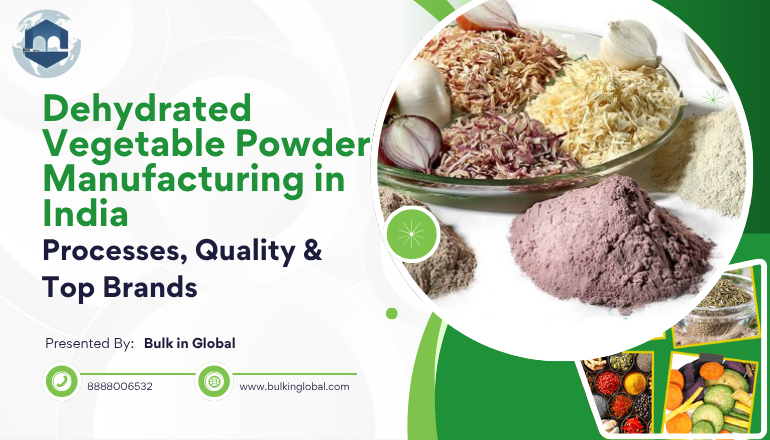


There’s a quiet revolution happening behind the scenes of your favorite soup mix, health bar, or even that fancy beetroot latte. It’s not loud. It doesn’t scream for attention. But it’s radically reshaping how the world consumes vegetables—without even realizing it.
We’re talking about dehydrated vegetable powders—a powerhouse of convenience, nutrition, and scalability. In simple terms, they’re just vegetables stripped of moisture. But in reality? They're so much more.
India, in particular, is emerging as a global manufacturing base for these powders. Not just for volume, but for the intricate balance of quality, versatility, and cost-effectiveness. From massive onion fields in Gujarat to ultra-hygienic freeze-drying units in Maharashtra, a quiet surge is building—and it's time the world paid attention.
This piece takes you through every major detail. How they're made. Why they're demanded. Who’s leading. And the catch no one talks about when trying to buy from India.
In the last five years, the global clean-label movement has reshaped how industries use ingredients. And if there’s one segment that has surged as a result—it’s dehydrated vegetable powders.
The market for these powders in India was worth around INR 4,900 crore in 2023 and is expected to reach INR 8,200 crore by 2028. That’s a growth rate hovering near 8.3% CAGR—driven not just by exports but by domestic industrial use in snacks, spice mixes, soups, beverages, and even pet foods.
What’s even more impressive is India’s export orientation. Close to 65% of production is routed for international buyers—largely from the US, Europe, UAE, Saudi Arabia, and Japan. Onion and garlic powders dominate, followed by tomato, beetroot, spinach, and carrot.
And yet, this growth isn’t purely demand-led. It’s built on India’s strengths:
But let’s not assume it’s all perfect. The real story? Is in the processing.
Walk into a modern Indian dehydration plant, and you’ll notice something strange—it looks more like a pharmaceutical unit than a farm-linked operation.
And that’s the whole point.
Let’s break down what happens step by step—because every single stage determines taste, color, nutrition, and shelf life.
It all begins with selection. You can't just pick up any tomato or onion from a mandi and expect it to work.
Factories collaborate with farmers through contract farming or direct procurement. They're looking for:
In states like Gujarat (onion) and Andhra Pradesh (tomato), specialized clusters have formed—essentially raw material hubs for industrial processors.
Once inside the plant, vegetables go through high-pressure washing, then mechanical peeling, optical sorting, and slicing. Any vegetable with over 2% bruising is rejected.
Some facilities even use ozonated water for microbial decontamination at this stage.
This step isn't about just hygiene—it's about pre-empting spoilage later. One bad input in a 2 MT batch can ruin an entire lot post-drying.
Now comes the defining step—removing water without compromising the compound structure of the vegetable.
There’s no one-size-fits-all. Different vegetables and use-cases require different dehydration methods:
Moisture levels post-drying?
Target is under 6% for most vegetables to ensure shelf-stability up to 2 years.
The dried flakes or chips are ground into powder using pin mills or hammer mills, depending on the desired mesh size (usually 40–100 mesh).
Uniformity matters. A foodservice buyer might want coarser particles. A baby food manufacturer? Needs ultrafine, microbiologically neutral powder.
This is where the real B2B magic happens. Buyers often request:
Some facilities also create pre-mixes for soup bases or seasoning lines, exporting directly in retail pouches or PET jars.
If moisture gets in, it’s game over. So, powders are vacuum-sealed or nitrogen-flushed in PET/aluminum laminate bags.
Cold storage isn’t mandatory for hot air-dried products—but freeze-dried powders? Stored below 25°C, with humidity <40%.
This is where the manufacturing units make or break their global potential.
Every batch undergoes:
Larger exporters also conduct GC-MS analysis to trace any volatile loss during drying.
Certifications include:
Also, brands catering to the infant food segment require zero-tolerance microbial benchmarks, which is a massive ask.
Let’s talk about what most glossy brochures won’t.
A quick look at who’s at the top—and what to expect when sourcing.
Known for: Bulk onion and garlic powder
Strengths: Price competitive, strong export linkages
Challenges: MOQ rigidity, limited flexibility for startups
Known for: Freeze-dried beetroot, carrot, and exotic blends
Strengths: Innovation and quality
Challenges: High pricing, not SME-friendly
Known for: Organic, pharma-grade powders
Strengths: USDA & EU organic certified
Challenges: Narrow SKUs, higher price per kg
Known for: White and pink onion powders
Strengths: Mass exporters
Challenges: Less responsive to niche custom requests
Known for: Contract manufacturing and premixes
Strengths: Large capacity, B2B export focus
Challenges: Long onboarding time, high order value
This is where the puzzle comes together.
Bulk in Global, headquartered in Kolhapur, Maharashtra, does something different. It doesn’t produce—it orchestrates.
If you’ve struggled to access Indian suppliers due to MOQ barriers, limited communication, or unpredictable timelines—Bulk in Global bridges that divide with real-time coordination and supplier aggregation.
Dehydrated vegetable powder is no longer a side player. It’s front and center in the clean-label movement, food innovation, and export growth—and India is becoming the global pantry for it.
But behind the success lies complexity: drying techniques, microbial control, sourcing struggles, and traceability issues.
Only the brands that understand both the science of processing and the art of export navigation can truly dominate.
And in that space—Bulk in Global isn’t just participating. It’s reshaping how the world sources from India.
What vegetables can be made into powder?
A wide range—onion, garlic, tomato, spinach, beetroot, carrot, moringa, mushroom, and ginger top the list. Each serves a different purpose:
Onion and garlic for seasoning, beetroot and spinach for health blends, tomato for sauces, and moringa for functional nutrition. The key is choosing veggies with good fiber structure and low post-harvest moisture.
12 to 24 months, depending on how it's made and stored.
Mostly yes—but it depends on the drying method.